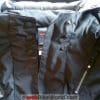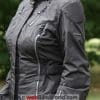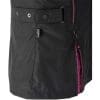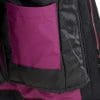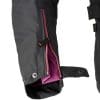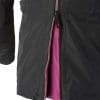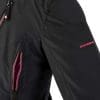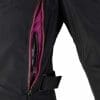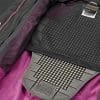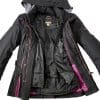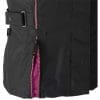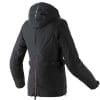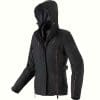The Spidi Stormy H2Out Jacket combines street wear with waterproof motorcycle protection. It has “Urban” style that makes it versatile off the bike as well as on. The jacket is very comfortable, warm, windproof and waterproof, making it an excellent choice for three-season use. It has Spidi style and construction that is stylish, easy-to-wear and that works.
While the Spidi Ace Leather Jacket I reviewed recently represents the ultimate in luxury and decadence, the Spidi Stormy H2Out Jacket is a wonderful example of practicality and versatility. This jacket is quite different from any other riding jacket I own.
It bears a striking resemblance to my regular winter street coat; remove the Stormy’s protectors and it would be hard to tell the two apart. I wore it down to bike night at the local bar and no one had any idea it was a motorcycle jacket. I had to show them the protectors before they believed me.
The Stormy jacket is part of the new “Urban” trend; that is, motorcycle gear that doesn’t look like motorcycle gear. It’s meant to be worn in cooler, inclement weather but the Stormy is so lightweight and comfortable, you may be tempted to grab it every time you leave the house. So let’s take a closer look!
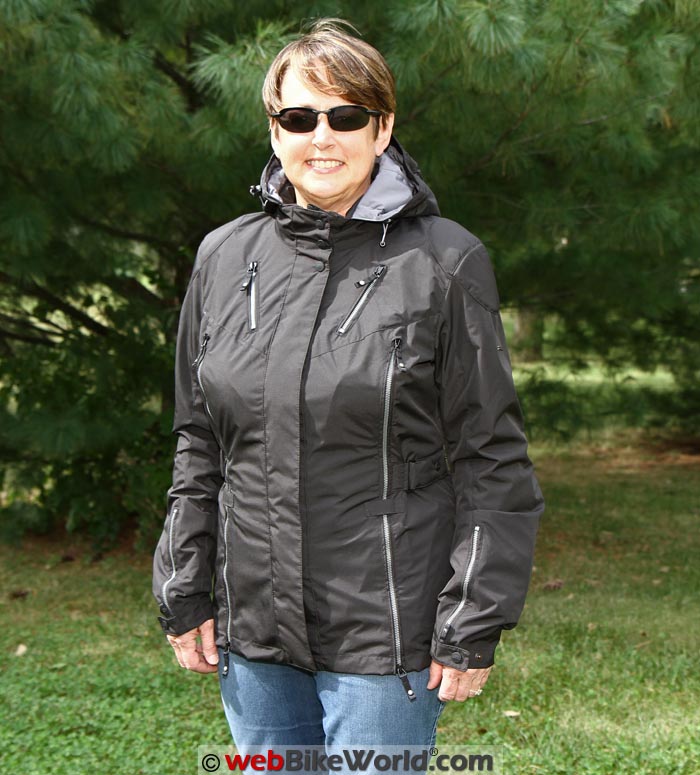


Construction
The outer shell of the Stormy H2Out Jacket is a double layer polyester laminate. It’s very soft and silky feeling and as I mentioned, it’s very light weight. Aside from the protectors, the jacket barely weighs anything at all.
Spidi doesn’t publish any data about the abrasion resistant properties of the outer layer but since it’s used as the outside shell of a motorcycle jacket, I trust it won’t disintegrate on contact…although I’m not sure I want to test that hypothesis. The H2Out waterproof liner is attached on the inside and it is the light grey material seen in the photos on the inside of the jacket.
This waterproof layer has the same silky-soft feel as the outer shell, so you don’t feel like you’re wearing a PVC tarp. According to Spidi, their H2Out material was created in collaboration with Toray, a Japanese group, and has a “beehive” micro-porous structure made specifically for motorcyclists.
This layer is also windproof and breathable. On the inside of the sleeves and top portion of the jacket is a lining of mesh fabric that keeps the jacket from sticking to you in warmer temperatures and this also makes it easy to slide in and out of the jacket.
The detachable thermal liner is a fairly thick, non-branded, 100 gram quilted type. It attaches with a short nylon zipper on each side that zips down from the top, similar to the Ace jacket.
The zippers are also unbranded but work smoothly and stay where they’re put. This liner is secured with a short length of fabric that feeds through a loop at the neck with a snap closure. The sleeves attach in a similar manner, with a short length of material that feeds through a loop on the inside of the sleeves and snaps closed. The sleeve loop is a bright red in color so it’s easy to find.
The Stormy Jacket is made with the same high quality construction we’ve found in other Spidi gear. For example, the stitches are all small, neat, and even throughout the jacket and the stress areas are double-stitched. Outside zippers and snaps are unbranded but they’re metal and pretty robust.
Spidi claims that all their gear has been put through rigorous testing that far exceeds conditions you would normally encounter in everyday riding, so I’m hoping for a monsoon to really put that to the test.
Pockets
Storage in the Stormy jacket is quite unique. There are long zippers on each side of the main zipper and zipping up from the bottom gives you an extra inch of room for the hips on each side.
But zipping down from the top reveals good-sized hand warmer-type pockets in the H2Out liner that are claimed waterproof. They’re positioned a bit higher than normal but my hands fit in them quite easily.
Two small diagonal pockets with a 4 inch opening are located on the chest. They are integrated into the outer jacket layers and have warning labels in them that they are not waterproof. There are no pockets inside the regular line, but the thermal liner does have a pocket on the left side placket that measures 5” x 6” and closes with a patch of hook-and-loop.
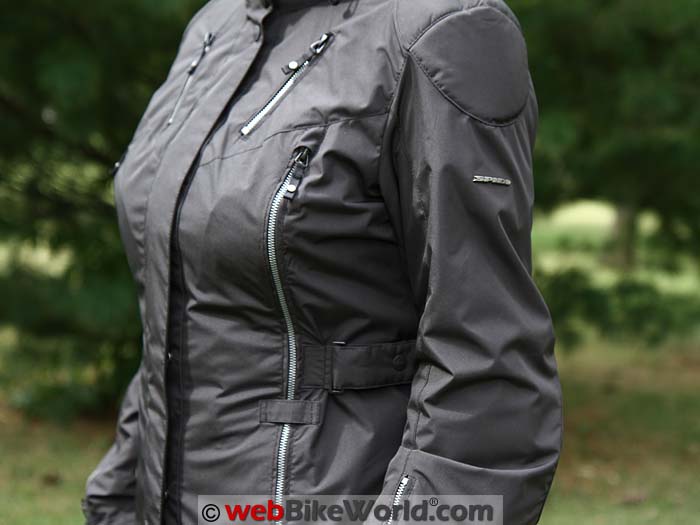


Fit Adjustments
Along with the two front adjustment zippers is an additional zipper in the back that gives another two inches of width for the hips. It comes in handy when you sit on the bike. All of the adjustment zippers are backed with a gusset of the H2Out liner. The light grey of the liner against the black of the coat looks nice and you’re not compromising the jacket’s ability to shed water.
The jacket fits so well that I didn’t have need for the extra room provided by the gusset, but it’s nice to have it available for those few weeks (months) after the holidays. They also help you fine-tune the fit if you’re removing or inserting the rather thick thermal liner. Waist adjustment is handled by a belt on either side that tightens with three snaps. You can tighten the waist by a total of 4 inches, which is about 3 more inches than I’ll ever need.
The waist belts do help to give the jacket some shape and a touch of femininity however. There are no adjustment straps on the sleeves, but I really didn’t need any because the sleeves fit snug enough to keep the elbow protectors in place while still allowing my elbows to move freely.
The sleeve ends have 7 inch zippers and a two-position snap closure. Between the two there is 4 inches of adjustment, so they will fit over top of most all my glove cuffs. The main zipper ends 5” from the bottom hem, so this area can be made wider when you’re seated on the bike.
This can also be adjusted and to keep the ends from flapping in the wind, with snaps that go all the way down to the bottom of the front storm flap. The exterior zippers on the Stormy jacket are all quite heavy-duty, with easy-to-use zipper pulls.
They don’t really feel like they’re the locking type but they don’t move once they’re adjusted. The exterior snaps are metal and hold very securely.
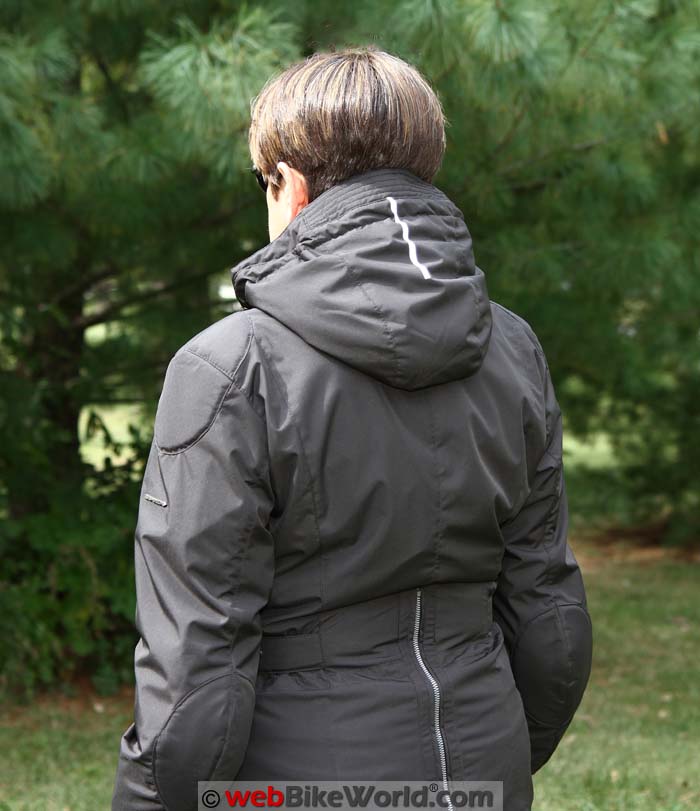


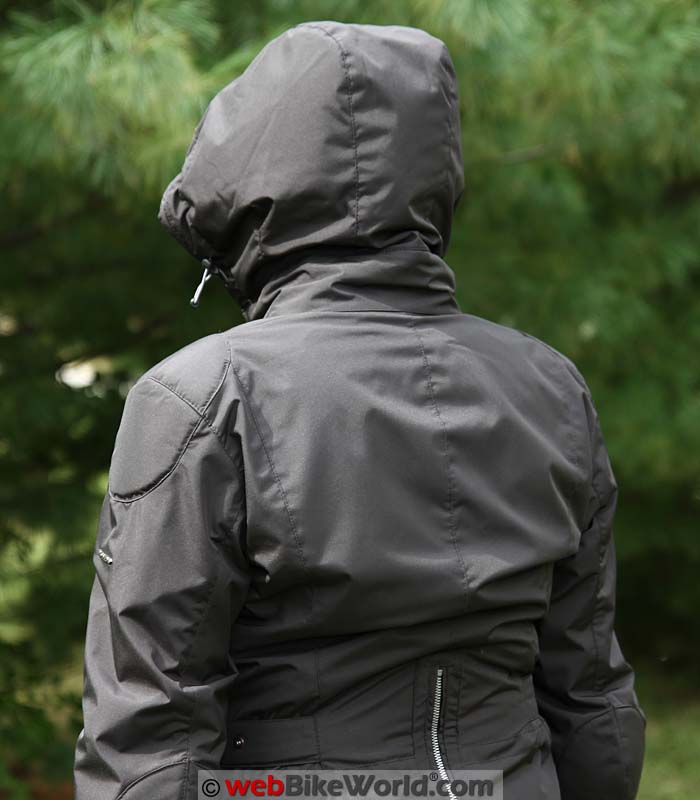


The Little Black Riding Hood
One of the unique features of the Stormy jacket is the attached waterproof hood. It’s permanently attached to the outer shell and it’s insulated, so it’s very warm. In the interest of full disclosure, jacket hoods never fit me correctly. I don’t know if my neck is too short or my head is too small (probably both), but there always seems to be way too much material. Even cinched all the way down with the duo elastic adjusters, the hood on the Stormy jacket comes down over my eyes and it looks like it’s covering a ’60’s hairdo.
So I have never owned a motorcycle jacket with a hood and I wasn’t real sure what to do with it. With the insulation, the hood is rather thick, so I wasn’t sure it was meant to fit under the helmet, but I tried it. It does fit, although it makes the helmet fit pretty snug and with a little finagling, I got it to stay out of my eyes.
That snug fit under the helmet does feel very cozy and it keeps me quite toasty. But while I might not wear the hood under my helmet very often, it’s nice to have the option in case the weather turns really nasty.
Protective Features
The Stormy jacket boasts EN1621-1 certified “Forcetech” protection in the shoulders and elbows. It’s the same pliant, unobtrusive type of protectors that are included in the Ace jacket, although I can feel the edges of the elbow protectors more through the thinner mesh liner of the Stormy jacket.
The elbows and shoulders also have extra padding sewn into the outer jacket shell.
And like the Ace jacket — and most of the other jackets in this price range — the Stormy doesn’t come with a back protector.
Spidi suggests adding the Warrior L2 back protector ($69.90 list at RevZilla) to fill that space, although I don’t see a dedicated pocket for it. But there is room for the top to slide under the mesh lining and attach to two large “loop” sections that apparently connect to “hook” sections on the protector.
Reflectivity
The Spidi website description lists reflectivity as a safety feature, but the only area I can get to light up is a small strip on the top of the hood. It’s very bright, but of course it would not be visible if the hood is folded or worn under a helmet.
Since the Stormy jacket is specifically designed to be useful in “stormy” weather when visibility is poor, it would have been nice to incorporate a few more reflective strips into the design.
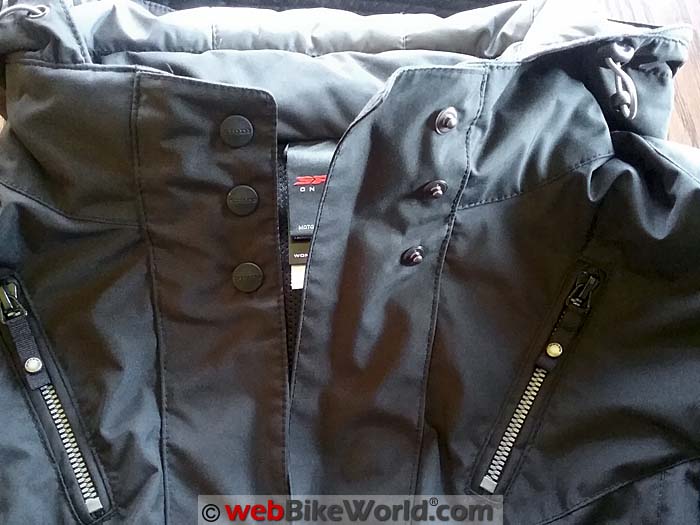


Is It Really Waterproof?
I guess I could have just climbed into the shower with the Spidi Stormy jacket to try it, but that really wouldn’t have mimicked real-world use. So I waited for a steady rainy day (unfortunately there were no monsoons in the 10 day forecast) and saddled up.
I rode for over an hour, time enough for my non-waterproof gloves to get soaked, but there was no water penetration through the Stormy jacket; most of the rain seemed to bead up and roll off the outer layer.
In areas where the outer layer did absorb some water, the H2Out liner on the inside kept me dry. The double layer storm flap in front of the jacket did its job as well, allowing no moisture through the main zipper.
I also evaluated the waterproof properties of the front hand warmer pockets by carrying my cell phone in one (which I think shows great faith and dedication on my part) and was rewarded with a dry phone.
I did not wear the hood, however.
Temperatures were in the low 70’s (21-23 C), which I deemed too warm for an insulated hood. But even without the extra protection of the hood, the fairly high collar of the jacket kept my shirt dry. Along with rain comes wind, so I was also able to also evaluate the windproof capability of the H2Out liner and it also passed with flying colors. I was perfectly comfortable, as I was both warm and dry, which is a good lead-in to cold weather performance.
With the thermal liner inserted, this is a seriously warm jacket. It allows very little wind penetration, so even at high speeds I didn’t feel cold. In fact, I’m not sure just how low the temperatures would have to get to beat the Stormy jacket, because my hands get too cold below 40 degrees F (4 C) to ride very far.
But at that temperature, I was still wearing a T-shirt underneath and was quite comfortable.
The neck of the jacket is tall and thick, so no wind penetrates and the sleeve cuffs tighten enough to prevent most of the air from infiltrating up the sleeves.
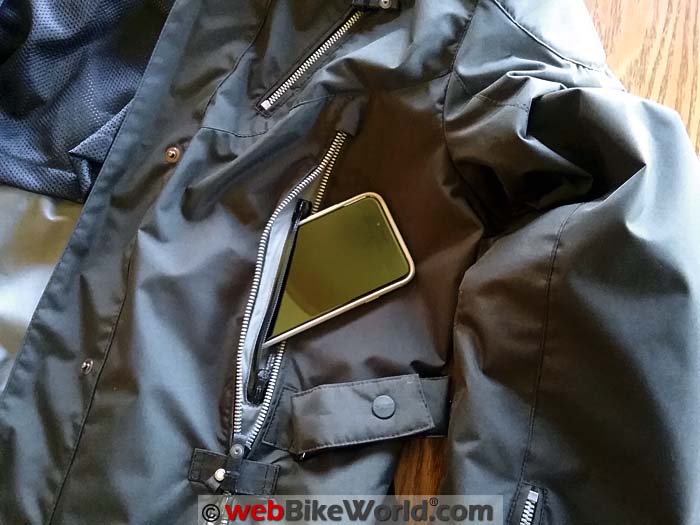


Ventilation
One cloudy, windy day I grabbed the Stormy jacket for an afternoon ride. It was about 70 degrees (F), so I left the thermal liner at home and took off with just a short-sleeved T-shirt underneath. I was perfectly comfortable until the sun came out and then the temperature soared into the mid 80’s (29 C) in the time it took me to ride a few miles and it became hot.
There are no dedicated vents in the Stormy jacket and with all the hatches battened down, it gets pretty warm pretty fast. The H2Out liner that performed so flawlessly in the rain and cold lets very little air get through when it’s warm and sunny…but that’s kind of the point of a windproof liner.
But the H2Out liner is supposed to be breathable and my torso remained dry, but that only goes so far as the temperatures climb. With the sun beating down on the black material and my arms in the narrow confines of the sleeves , I started to sweat.
Despite the mesh lining, the textile did stick to my arms a bit and caused a moment of panic when I went take the jacket off. So for me at least, the optimum riding temperature for the Stormy jacket is 35-85 degrees Fahrenheit or 2-30 C, making it a wonderful jacket for Fall, Winter and Spring.
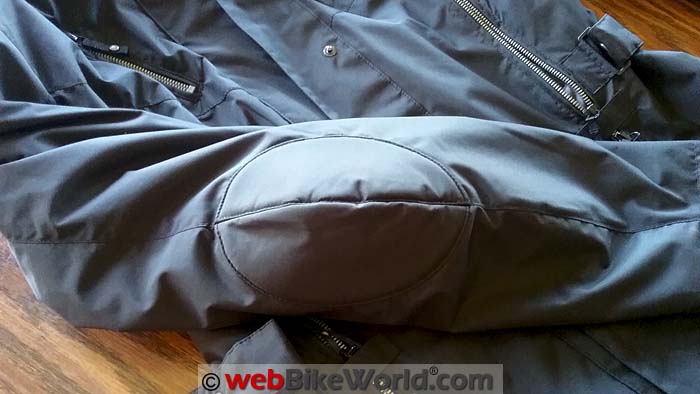


Sizing and Fit
The Spidi Stormy H2Out is a 3/4-length jacket and it comes down past my hips (although keep in mind I’m very short).
The Stormy jacket is available in sizes 40-50 Euro, which translates to US size XS to XXL and the size 46 Stormy jacket fits me the way I would expect for a typical US size large women’s jacket. So the size large, which is a European size 46, fits me very well.
It has a more generous fit through the chest area than the Spidi Ace jacket and if you need a little more room you can unzip the top part of the front adjustment zippers to give about another inch.
Aside from the silhouette of the elbow protectors, the Stormy jacket looks very much like a regular non-motorcycle street coat. There is minimal branding, just a small metal “Spidi” logo on the left shoulder.
Nothing screams “motorcycle jacket”, so this could easily pull double-duty if you’re going out one evening during a motorcycle trip.
Pricing
The Spidi Stormy H2Out jacket has a list price of $399.90. Spidi also has a leather version of the Stormy jacket, with a list price of $599.99. It is described as being 50% waterproof and leaves me wondering which half isn’t waterproof (!).
The leather version also doesn’t have a hood, so perhaps it’s your top half that’s going to get wet (or perhaps it’s just a translation issue).
Color Choices
Color choices are the black/grey color shown here and a black/fuchsia shown in the slide show above. The fuchsia version has a bright pink liner and inserts that would leave no doubt that you’re a woman. The Stormy jacket isn’t easy to find in retail, at least in the U.S.A. but it can be ordered directly from Spidi.



Conclusion
The Spidi Stormy H2Out Jacket is a beautifully made garment with the same high quality construction as all of the Spidi gear I’ve worn.
As with all “Urban” style gear, there are a few compromises, but the Stormy jacket is so versatile and comfortable, it’s easy to ignore them. The jacket is an excellent choice for Fall through Spring motorcycle riding and I’m also planning on wearing it off the bike, for everything from football games to skiing.
Overall, I’ve been very impressed with Spidi clothing. They make truly stylish, easy-to-wear gear that works. I wouldn’t hesitate at all to recommend Spidi to my riding friends.






